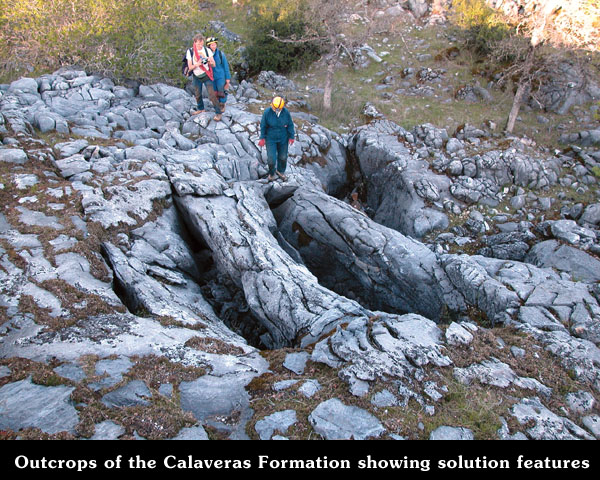Cave and Area Geology
A pocket geologic history of Mercer Caverns
Bruce Rogers
(USGS, retired)
Mercer Caverns formed in a large lens of recrystallized limestone and dolomitic limestone of the Calaveras Group, a wastebasket of miscellaneous slabs and slivers of rock found throughout the Sierra Nevada. In the vicinity of the Caverns, these scraps of ancient ocean floors, tropical atolls, and long-vanished continents appear to date from the 280-million-year-old Permian Period. These rocks were originally formed in past seas and stitched onto the western edge of North America by plate tectonics until just before the Age of Dinosaurs. Conditions changed by the time of the Miocene Epoch, which arrived some 24 million years ago. It appears that by the waning of the Miocene some 6 million years ago, acid-charged ground water in the tree-dotted savanna had already seeped down the cracks and fissures of the limestone and dissolved out the cave. As adjacent San Domingo Creek scoured its channel deeper, the cave slowly drained and, deprived of the ground water’s buoyant support, large sections of the cave’s ceiling collapsed. The nearly two million years of the Ice Ages came and went, leaving their mark on the cave as a series of ocherous clay deposits interspersed with massive calcite flowstone cascades and stalagmites. With the final waning of the ice sheets some 10,000 years ago, the walls of the Caverns were covered with thick deposits of calcite dripstone of all shades of white, cream, orange, and brown.

The Cavern’s decorations have formed from seeping and dripping water that is highly charged with dissolved calcite, the primary mineral in the marble. Percolating ground water picks up carbon dioxide generated as a waste product by soil bacteria and slowly dissolves the marble as it traverses down into the bedrock. When these solutions seep out onto the cave walls, the entrapped carbon dioxide boils out of the solutions much like an uncapped soda bottle, dropping its calcite load to deposit the myriad of forms decorating the Caverns. In the lowest sections of the cave, ponded water saturated with calcite encrusted everything with spiky, orange dogtooth spar crystals upwards of 2 inches long. Higher in the cave, ground water pressure was fed through tiny imperfections in the calcite sheathing and formed twisted, medusa-like helictites ranging from a hair’s thickness to massive 2-foot-long “lobster claws.”
Other seeping water slowly formed popcorn or coral-like decorations called coralloids. Gently flowing water, agitated by imperfections on the Cavern walls, also expelled their dissolved carbon dioxide and dropped their calcite load to form sheets of flowstone that resemble frozen waterfalls. In some places, seeping water, again under pressure, formed hollow calcite cave blisters among the coralloids and stalactites that later were partly filled with clay and “opal”. An unusual type of stalactite is found in the cave, where roots penetrating the roof have been coated to form rootsicles.
In a final frosting of the Caverns, solutions rich in calcium carbonate deposited walls of delicate aragonite crystals in the far recesses of the cave. As the minerals concentrated in what little solution remained, uncommon, blue-white, cream cheese-like hydromagnesite moonmilk formed on cave passage walls and on the spiky aragonite crystals. Resembling miniature ice-sheathed trees, this showy display of aragonite is so outstanding that a special prize was awarded to the Mercers at the 1900 Paris World's Fair.

